- Clone
- 1B1 (See other available formats)
- Regulatory Status
- RUO
- Other Names
- CD1, CD1.1, Ly-38
- Isotype
- Rat IgG2b, κ
- Barcode Sequence
- CAACTTGGCCGAATC
| Cat # | Size | Price | Quantity Check Availability | ||
|---|---|---|---|---|---|
| 123533 | 10 µg | $369.00 | |||
CD1d, known as CD1.1 and Ly-38, is a 48 kD type I membrane glycoprotein with structural similarities to MHC class I and is non-covalently associated with β2-microglobulin. In humans, CD1 family consists of group I proteins (CD1a, CD1b, and CD1c), group II (CD1d), and group III (CD1e). But CD1d is the only CD1 molecule has been found in mouse. Mouse CD1d has broad tissue distribution, and is found on leukocytes, dendritic cells, epithelial cells, and thymocytes. CD1d plays a role in non-peptide glycolipid antigen presentation to CD1d-restricted T cells. It has been shown that PKCδ is a critical regulator of CD1d-mediated antigen presentation.
Product Details
- Verified Reactivity
- Mouse
- Antibody Type
- Monoclonal
- Host Species
- Rat
- Immunogen
- Mouse Cd1.1 cDNA-transfected RMA-S mouse T lymphoma
- Formulation
- Phosphate-buffered solution, pH 7.2, containing 0.09% sodium azide and EDTA
- Preparation
- The antibody was purified by chromatography and conjugated with TotalSeq™-C oligomer under optimal conditions.
- Concentration
- 0.5 mg/mL
- Storage & Handling
- The antibody solution should be stored undiluted between 2°C and 8°C. Do not freeze.
- Application
-
PG - Quality tested
- Recommended Usage
-
Each lot of this antibody is quality control tested by immunofluorescent staining with flow cytometric analysis and the oligomer sequence is confirmed by sequencing. TotalSeq™-C antibodies are compatible with 10x Genomics Chromium Single Cell Immune Profiling Solution.
To maximize performance, it is strongly recommended that the reagent be titrated for each application, and that you centrifuge the antibody dilution before adding to the cells at 14,000xg at 2 - 8°C for 10 minutes. Carefully pipette out the liquid avoiding the bottom of the tube and add to the cell suspension. For Proteogenomics analysis, the suggested starting amount of this reagent for titration is ≤ 1.0 µg per million cells in 100 µL volume. Refer to the corresponding TotalSeq™ protocol for specific staining instructions.
Buyer is solely responsible for determining whether Buyer has all intellectual property rights that are necessary for Buyer's intended uses of the BioLegend TotalSeq™ products. For example, for any technology platform Buyer uses with TotalSeq™, it is Buyer's sole responsibility to determine whether it has all necessary third party intellectual property rights to use that platform and TotalSeq™ with that platform. - Application Notes
-
Additional reported applications (for the relevant formats) include: immunoprecipitation, immunohistochemistical staining, and blocking function3.
This product is for research use only and is not to be used for commercial purposes. Use of this product to produce products for sale or for diagnostic, therapeutic or drug discovery purposes is prohibited. In order to obtain a license to use this product for commercial purposes, contact the Regents of the University of California.
- Additional Product Notes
-
TotalSeq™ reagents are designed to profile protein levels at a single cell level following an optimized protocol similar to the CITE-seq workflow. A compatible single cell device (e.g. 10x Genomics Chromium System and Reagents) and sequencer (e.g. Illumina analyzers) are required. Please contact technical support for more information, or visit biolegend.com/totalseq.
The barcode flanking sequences are CGGAGATGTGTATAAGAGACAGNNNNNNNNNN (PCR handle), and NNNNNNNNNCCCATATAAGA*A*A (capture sequence). N represents either randomly selected A, C, G, or T, and * indicates a phosphorothioated bond, to prevent nuclease degradation.
View more applications data for this product in our Scientific Poster Library. -
Application References
(PubMed link indicates BioLegend citation) -
- Fischer K, et al. 2004. P. Natl. Acad. Sci. USA 101:10685. (Block)
- Brozovic S, et al. 2004. Nat. Med. 10:535.
- Brossay L, et al. 1997. J. Immunol.. 159:1216. (Block)
- Jiang J, et al. 2012. PLoS One. 7:47487. PubMed
- RRID
-
AB_2860654 (BioLegend Cat. No. 123533)
Antigen Details
- Structure
- 48 kD glycoprotein, Ig superfamily
- Distribution
-
leukocytes, dendritic cells, epithelial cells, thymocytes
- Function
- Antigen presentation
- Ligand/Receptor
- similar to MHC class I, associate with ß-microglobulin
- Cell Type
- Dendritic cells, Epithelial cells, Leukocytes, Thymocytes
- Biology Area
- Immunology, Innate Immunity
- Molecular Family
- Adhesion Molecules, CD Molecules
- Antigen References
-
1. Brudin N, et al. 1998. J. Immunol. 161:3271.
2. Amano M, et al. 1998. J. Immunol. 161:1710.
3. Brossay L, et al. 1997. J. Immunol. 159:1216.
4. Dougan SK, et al. 2007. Curr. Top. Microbiol. Immunol. 314:113.
5. Brutkiewicz RR, et al. 2007. Eur. J. Immunol. 37:2390. - Gene ID
- 12479 View all products for this Gene ID
- UniProt
- View information about CD1d on UniProt.org
Other Formats
View All CD1d Reagents Request Custom Conjugation| Description | Clone | Applications |
|---|---|---|
| Purified anti-mouse CD1d (CD1.1, Ly-38) | 1B1 | FC,IHC,IP |
| Biotin anti-mouse CD1d (CD1.1, Ly-38) | 1B1 | FC,IHC |
| FITC anti-mouse CD1d (CD1.1, Ly-38) | 1B1 | FC |
| PE anti-mouse CD1d (CD1.1, Ly-38) | 1B1 | FC |
| Alexa Fluor® 647 anti-mouse CD1d (CD1.1, Ly-38) | 1B1 | FC |
| PerCP/Cyanine5.5 anti-mouse CD1d (CD1.1, Ly-38) | 1B1 | FC |
| Pacific Blue™ anti-mouse CD1d (CD1.1, Ly-38) | 1B1 | FC |
| PE/Dazzle™ 594 anti-mouse CD1d (CD1.1, Ly-38) | 1B1 | FC |
| APC anti-mouse CD1d (CD1.1, Ly-38) | 1B1 | FC |
| PE/Cyanine7 anti-mouse CD1d (CD1.1, Ly-38) | 1B1 | FC |
| APC/Fire™ 750 anti-mouse CD1d (CD1.1, Ly-38) | 1B1 | FC |
| Brilliant Violet 421™ anti-mouse CD1d (CD1.1, Ly-38) | 1B1 | FC |
| TotalSeq™-A0851 anti-mouse CD1d (CD1.1, Ly-38) | 1B1 | PG |
| Ultra-LEAF™ Purified anti-mouse CD1d (CD1.1, Ly-38) | 1B1 | FC,Block,IHC,IP |
| TotalSeq™-C0851 anti-mouse CD1d (CD1.1, Ly-38) | 1B1 | PG |
| TotalSeq™-B0851 anti-mouse CD1d (CD1.1, Ly-38) | 1B1 | PG |
Compare Data Across All Formats
This data display is provided for general comparisons between formats.
Your actual data may vary due to variations in samples, target cells, instruments and their settings, staining conditions, and other factors.
If you need assistance with selecting the best format contact our expert technical support team.
-
Purified anti-mouse CD1d (CD1.1, Ly-38)
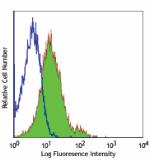
C57BL/6 mouse splenocytes stained with purified 1B1, followe... -
Biotin anti-mouse CD1d (CD1.1, Ly-38)
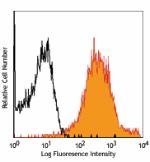
C57BL/6 mouse splenocytes stained with biotinylated 1B1, fol... -
FITC anti-mouse CD1d (CD1.1, Ly-38)
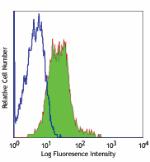
C57BL/6 splenocytes stained with 1B1 FITC -
PE anti-mouse CD1d (CD1.1, Ly-38)
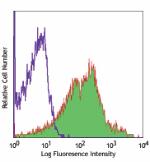
C57BL/6 splenocytes stained with 1B1 PE -
Alexa Fluor® 647 anti-mouse CD1d (CD1.1, Ly-38)
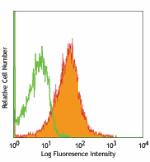
C57BL/6 splenocytes stained with 1B1 Alexa Fluor® 647 -
PerCP/Cyanine5.5 anti-mouse CD1d (CD1.1, Ly-38)
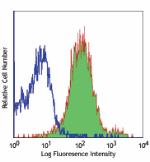
C57BL/6 mouse splenocytes stained with 1B1 PerCP/Cyanine5.5 -
Pacific Blue™ anti-mouse CD1d (CD1.1, Ly-38)

C57/B6 mouse splenocytes were stained with CD1d (clone 1B1) ... 
-
PE/Dazzle™ 594 anti-mouse CD1d (CD1.1, Ly-38)
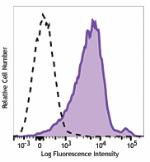
C57BL/6 mouse splenocytes were stained with CD1d PE/Dazzle™ ... -
APC anti-mouse CD1d (CD1.1, Ly-38)
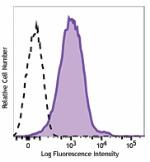
C57BL/6 mouse splenocytes were stained with CD1d APC (clone ... -
PE/Cyanine7 anti-mouse CD1d (CD1.1, Ly-38)
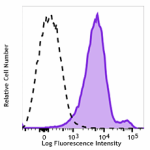
C57BL/6 mouse splenocytes were stained with CD1d PE/Cyanine7... -
APC/Fire™ 750 anti-mouse CD1d (CD1.1, Ly-38)

C57BL/6 mouse splenocytes were stained with B220 FITC and CD... -
Brilliant Violet 421™ anti-mouse CD1d (CD1.1, Ly-38)

C57BL/6 mouse splenocytes were stained with CD45R/B220 APC a... -
TotalSeq™-A0851 anti-mouse CD1d (CD1.1, Ly-38)
-
Ultra-LEAF™ Purified anti-mouse CD1d (CD1.1, Ly-38)
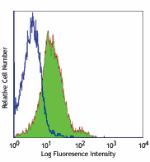
C57BL/6 mouse splenocytes stained with Ultra-LEAF™ Purified ... -
TotalSeq™-C0851 anti-mouse CD1d (CD1.1, Ly-38)
-
TotalSeq™-B0851 anti-mouse CD1d (CD1.1, Ly-38)
